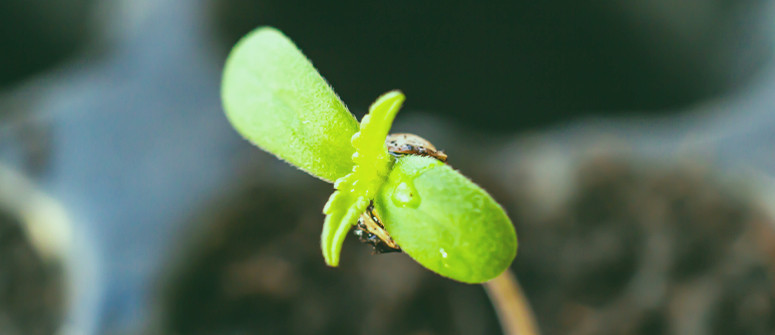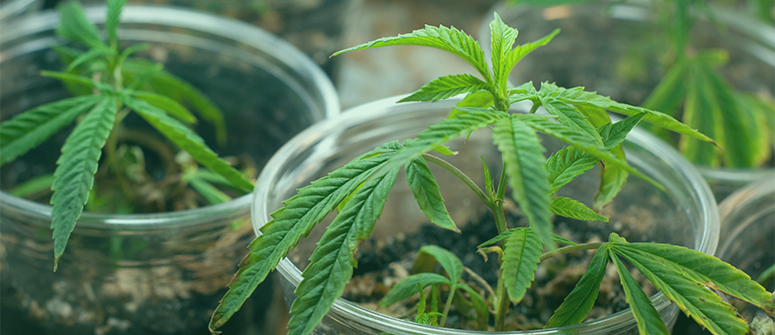8 cannabis seedling problems and how to fix them

Cannabis seedlings are surprisingly robust and, if given ample space and a good environment, mostly take care of themselves. Still, problems can occur during the seedling phase, and if they do, you need to know what to do. Here we explore eight common cannabis seedling problems, and discuss how to fix or prevent them.
Contents:
In this article, we will look at eight common and (mostly) reversible problems that can afflict cannabis seedlings. The good news is that, in most cases, you can cure your young plants and still have a healthy crop—and you’ll soon find out how.
If you’re having problems with seed germination and your seeds are not sprouting, then check out our dedicated article outlining why seeds might not germinate.
What should cannabis seedlings look like?

Cannabis seedlings should appear bright green, tender, smooth, and generally healthy. A healthy seedling will emerge from the soil with cotyledons, which are the first two leaves that are already formed within the seeds. These leaves are smooth with rounded edges, and are not considered “true” leaves. They do not grow any larger and remain at the base of the stem until they drop off.
As a seedling grows, the first set of true leaves will emerge. There will be two of them, and they will have the serrated edges that we associate with cannabis. These leaves will grow and become larger over time. Over the first 10–14 days of growth, a cannabis seedling should grow considerably in height and overall size, with between three and four sets of true leaves by the end of this period, at which point it can be considered a vegetative cannabis plant—no longer a seedling.
You shouldn’t just look to the leaves for information, though. A plant’s stem is just as vital, as it houses the xylem and phloem, which transport water and nutrients around the plant, and provide the sturdiness that keeps them upright.
Stems will grow a lot during the first weeks of growth, but they should remain proportional to the overall growth. Seedlings that appear overly tall, or “leggy”, are known as stretching seedlings, which can cause problems, such as falling over. The main culprit of stretching, aka etiolation, in seedlings is a lack of adequate light.
8 common weed seedling problems and how to fix them
If you use good seeds, good soil, and grow in the right conditions, then most seedlings should appear healthy and grow well. However, despite our best efforts, sometimes problems can occur. In the following section, we will outline eight common problems that you might encounter during the seedling stage of your cannabis plant’s growth. With each issue, we'll offer some solutions or prevention techniques to ensure your grow isn't thwarted before it's even really started.

1. Dying seedlings
There are numerous potential causes behind dying seedlings, but the most common is a condition known as damping off. Damping off is a generic name given to a range of fungal infections that first affect the roots of seedlings grown in soil, and will swiftly kill them. They can even infect seeds and prevent germination altogether.
Damping off will cause seedlings to wilt, looking weak and soggy, then fall over and die. There are multiple potential causes behind damping off, with the most common being too much water in the soil, which leads to the development of certain fungi, such as Pythium. Soil with too many nutrients can also make damping off more likely.
What to do
Unfortunately, you can’t cure seedlings of damping off. But you can easily prevent it from occurring in the first place, and thereby remove one of the greatest dangers for seedlings.
To avoid damping off, you should always use clean, high-quality soil. Soil that has been used before may already contain Pythium and other dormant fungi. Moreover, you should avoid water-logging the soil, and stick to organic nutrients. In fact, seedlings grown in soil don’t need additional nutrients, so leave the feed out entirely.
You can also amend soil with beneficial microbes such as mycorrhizal fungi, which form a symbiotic relationship with cannabis roots and help to protect them from pathogens, and allow them to absorb nutrients more efficiently.
2. Yellow spots on leaves
Yellow spots on leaves can indicate multiple problems:
- Nutrient problems: There’s essentially no risk of underfeeding with seedlings, at least in soil, but they can easily be overfed. As mentioned, if growing in soil, there’s no need to feed at all for the first three or four weeks of growth. Overfeeding can stop the roots from absorbing nutrients properly, and seedlings are particularly sensitive.
- Pathogens: Yellow spots can also appear as a result of insects, such as whiteflies, feeding on leaves. Where they puncture the outer surface to consume the sap, yellow spots will be left behind. These will often then turn brown.
What to do
In the case of overfeeding, your best bet is to avoid administering nutrients altogether. Seedlings in soil need no additional feed, and seedlings in inert media need very little. Depending on how you're growing, flushing the media of excess nutrients can be very difficult, so it’s best to avoid it. It’s always better to potentially underfeed your seedlings than overfeed.
In the case of insects, it depends on the age of your seedlings. Insecticidal soaps can work well with slightly older plants, but can be damaging for very young seedlings—though they might be the only option. A better bet is to carefully observe your plants and try to manually remove any insects before they begin causing harm.
3. Spindly seedlings, tiny leaves
If seedlings grow tall and spindly, with underdeveloped leaves, then it’s most likely a lack of light that’s causing this problem. As soon as they emerge, seedlings strive towards the light, as this is essential to their development. If they have adequate light, then they will grow less tall, as they will not attempt to emerge from the perceived undergrowth. If there’s inadequate light, they will attempt to grow tall and fast, in the hope of emerging above whatever is blocking the light.
Spindly stems are less able to support the weight of leaf and bud growth, and will eventually fall over if they are not supported. If you want to avoid having to physically support your plants throughout their whole life, then it’s important to stop them from stretching.

What to do
The best way to prevent seedling stretching is to use high-quality lights at the right distance. If you’re using CFL or LED lights, then you should place them around 10cm from the top leaves. If you’re using some kind of high-intensity light (such as HPS), then you should place them around 50cm from the top leaves, otherwise you may well burn your plants.
4. Droopy, yellow leaves
Droopy seedlings are usually the result of overwatering. They won’t become crispy and wilted, but rather will sag, developing yellow leaves that eventually become brown.
What to do
With older plants, you can remove them from the soil, dry and prune their roots, and repot them. You can’t really do this with seedlings, so your options are somewhat limited. You could try transplanting them if they’re close to that stage anyway, and hope that the new soil absorbs much of the excess water—but it might be too late.
Better to avoid overwatering in the first place. Alongside not overwatering, you can improve drainage by mixing perlite into the soil and using pots that drain well, including fabric pots.
5. Dry, crispy, and burnt leaves
These symptoms could have multiple causes:
- Underwatering: If your seedlings appear dry and wilted, with yellow leaves, then they might be dehydrated. If the soil is moist, this cannot be the case. Seedlings will not become dehydrated unless the soil is totally dry.
- Light burn: If your indoor grow lights are too close to the seedling, it can manifest as burning of the leaves.
- Overfeeding: If you overfeed, leaves may appear burnt and crispy. If you’ve ruled out dehydration and light burn, then this may be the case.
What to do
Depending on the cause, you can treat dry, crispy, and burnt leaves by doing the following:
- The solution for dehydrated plants is simple—water them! They should recover quickly.
- If your grow light is too close, move it further away, following the guidelines from the section “Spindly seedlings, tiny leaves”.
- For plants that have been overfed, you’ll need to flush the growing medium to remove excess nutrients, and start fresh.
6. Stalled growth and discoloured leaves
If growth has stalled after the first true pair of leaves have emerged, and the leaves appear a pale yellow, it’s probably due to a lack of nitrogen. Seedlings are able to develop their first true set of leaves without additional nutrients, but after this, they need help.
What to do
If you’re growing in soil, it’s very unlikely that underfeeding will be a problem for seedlings, and you should be very cautious about adding fertiliser. If you’re growing in inert media, then it’s more likely to be a problem.
Add as little fertiliser as possible, as plants this small need very little to be satiated. Follow instructions carefully, and don’t be tempted to overcompensate!

7. Seedlings with a seed shell on them
If humidity levels aren’t high enough, then seedlings might not be able to shed their shells properly. This can stop leaves from developing as they should, and, if untreated, can eventually kill plants, depending on the severity of the issue.
If the shell is stuck to the base of the stem, it can be unproblematic. But if it’s covering the leaves, then it can be a real issue and should be treated.
What to do
It’s easy enough to fix this problem if it occurs. First, you should try spraying the seed and seedling with a mist of water. Often, this extra moisture will be enough to help the shell drop away. If this doesn’t work, then you can use a pair of tweezers to (very carefully) remove the shell manually.
Make sure that the soft membrane that lines the inside of the shell is also removed, because if this remains stuck to the leaves, it can still cause problems.
8. Poorly developed roots
It can be hard to tell if the roots are developing properly or not, but if the plant seems to be struggling to grow and you’ve ruled out other options, it might be a root-related problem.
What to do
Seedlings require a lot of blue light in order to develop their roots properly. Most cannabis grow lights should emit enough of this light, but ensure that LEDs are switched to the veg setting, not bloom.
If you suspect your lights aren’t good enough, then you can use CFL lights for seedlings, which emit ample blue light and are perfect for the early stages of cannabis growth.
Can stunted cannabis seedlings recover?
It really depends on the cause, but overall the outlook is positive. For certain problems, recovery can be expected, often with no lasting damage. Seedlings can recover from:
- Underwatering
- Overfeeding
- Improper lighting
- A stuck shell
- Underfeeding
- Pathogens
They will not recover from:
- Damping off
- Overwatering
Final tips for the cannabis seedling stage

Here are some general tips for growing cannabis seedlings successfully:
- Create the best growing conditions for cannabis seedlings: This means a temperature of around 23°C, a relative humidity of about 60%, appropriate lighting, good airflow, and minimal stress.
- Know how to handle seedlings: Plants at this stage are very delicate, and they need to be handled gently and minimally.
- Be conservative: Do not overfeed or overwater. Both of these are much worse than underfeeding/watering, so always be conservative rather than decadent.
- Use appropriate growing containers: You should leave seedlings in a propagator until they are too big for it, as this creates the ideal, protected environment.
- Transplant carefully: Knowing how and when to transplant seedlings from seed trays is a crucial skill. The quick answer is: when they have 3–4 sets of leaves. Transplanting puts the plants in their next, and often final, home, so it’s important to get it right.
Avoid problems and grow happy cannabis seedlings
Problems will always occur, but knowing about them in advance can make their occurrence much less likely. And, as you can see, most of the issues that might afflict cannabis seedlings can be solved, so all is not lost if something goes wrong!
.jpg)
.jpg)

.jpg)
